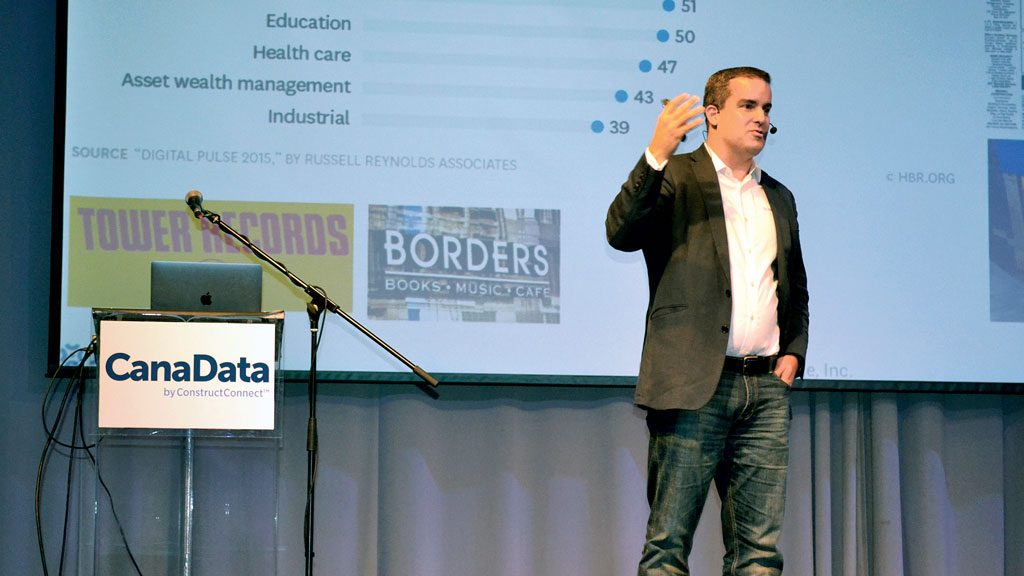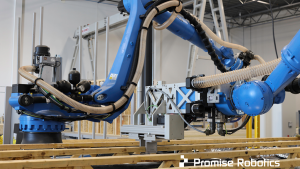The construction sector has reached a tipping point in 2018 where excuse-making contractors who resist adopting new technology will most certainly lose out to the growing number of competitors who have embraced it.
That was the message from James Benham, founder and CEO of Texas-based JBKnowledge Inc., who addressed guests attending the CanaData 2018 conference held in Toronto Oct. 18.
His presentation was replete with illustrations of how modern tech strategies result in significant savings at every stage of the construction process — from machine learning that automatically catalogues site photographs and generative design that undertakes automated rebar design to immersive hybrid reality that revolutionizes safety training and 3-D printing that spits out simple detached homes for as little as $10,000.
“This is the only industry where productivity has gotten worse rather than better in the past 30 years,” Benham said. “Owners are not happy about it. And so I really feel like now, if you are not using Revit, and you come up with all these lame excuses about projects that don’t apply to virtual design and construction, which I hear a lot…I say, I’m sorry, because I know three of your competitors who use it on everything.
“We are at Malcolm Gladwell’s tipping point in 2018. When I started speaking to construction organizations 13 years ago we were not there. We were at the beginning of this. In 2018, we’re there.”
More and more, Benham said, owners are specific about how they want projects undertaken. It’s especially so if the owner itself is in the technology field.
“They want cameras onsite, they want worker tracking, they want Revit, they want modelling, they want BIM-to-Field, because they want to drive the cost of construction down,” he said.
Each year Benham’s firm prepares a technology report that surveys constructors on their practices and attitudes towards the adoption of technology.
The 2017 report found construction continues to budget the least for information technology among similar industries. The survey revealed 46.4 per cent of construction companies are spending less than one per cent of revenues on IT and another 21.8 per cent spent just one per cent on IT.
This, despite ample evidence of the time and cost savings and productivity gains smart investments can make, he said.
Alice, for example, a construction planning and scheduling software tool Benham discussed, runs through millions of scheduling options to recommend an optimal schedule, saving 16.2 per cent on average on project schedule and 14.7 per cent on project budget.
Usually, a schedule completely goes out the window 10 minutes after it’s adopted, Benham said.
“This machine learns how you schedule,” he said. “This is a huge deal. One of the biggest problems in construction is timeliness.”
Among other examples cited, GenMap can create routing for mechanical systems that can easily save multiple hours over traditional methods; software that compared stick-build and prefab processes on a similar job found the prefab system saved 58 hours in work time and significant miles walked; and PlanGrid increases efficiency by providing project teams with access to all project drawings and documents.
“People screw up plans all the time, they build on the wrong revision sets,” he said, noting a significant number of contractors still do their plans on paper.
Trackables and wearables that document mobility on sites can even recommend efficiencies on portable toilets, Benham said. Moving the portable to an optimal spot every day so workers don’t have to walk too far can save five minutes.
“If you can’t measure it, you can’t manage it,” he said.
Adopters of new technology will find sophisticated solutions to design challenges that were just not possible using traditional methods. The Elbphilharmonie, a concert hall in Hamburg, Germany, was a case in point, Benham said. There, a new level of acoustical excellence was achieved using software to configure ceiling panels.
“Each one has a unique fingerprint, to refract and reflect sound so each seat could have as close to perfect sound as possible,” he said.
There are also numerous applications for construction safety. Benham explained how a Spot-r clip attached to a worker’s belt can track falls or other unsafe behaviour. At one workplace it was documented that workers were falling three feet 50 times a day. It was determined they were jumping off trucks – unnecessarily hazardous acts that could risk knee injuries repeated so often.
Benham wrapped up with a few simple rules for builders aiming to take maximum advantage of available technology.
First, focus on full adoption of the tech identified – make maximum use of training and support. Become a tinkerer – test out a product and if it does not serve the firm’s needs, return it.
“Be an innovator, not a naysayer,” he said. “The answer is not no, the answer is, let’s investigate.”










Recent Comments